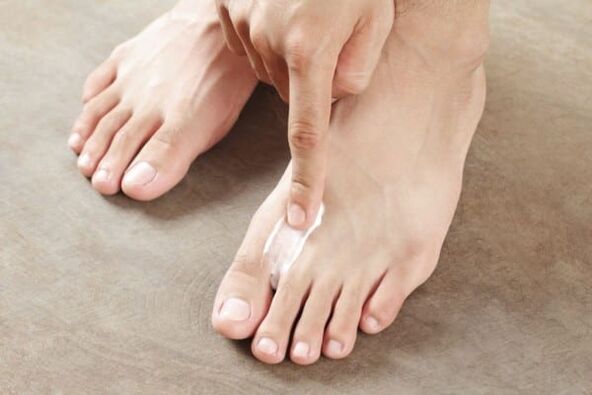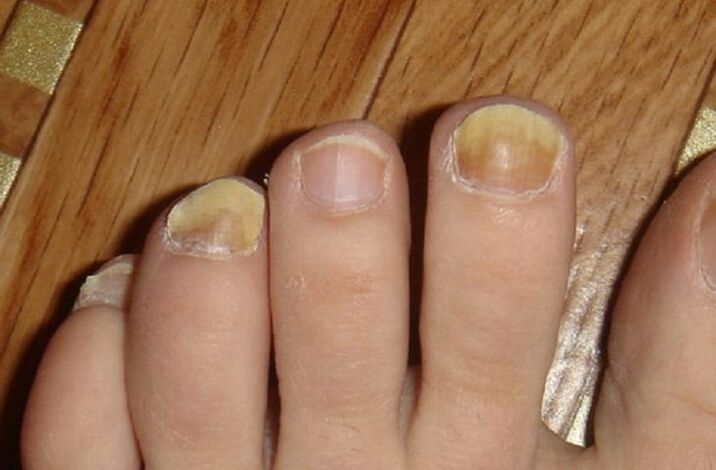Fungus on the skin of the feet is one of the most common infections. Fungus on the feet is distinguished by its vitality and ease of development. If you rely on statistics, then 20% of the world’s population suffers from fungus.

What is Skin Fungus?
Fungal diseases are infectious diseases that affect the skin. The most common type of fungus is mycosis. In medicine, these skin diseases are divided into several types.
Fungi can adapt to almost any habitat conditions. Fungal spores are able to live long in ordinary clothing or shoes. In most cases, fungal infections are exposed to the feet and nail plates on a person’s feet.
How does mycosis occur?
The causative agents of foot mycosis are the fungi Trichophyton rubrum, T. Mentagrophytes and Epidermophyton floccosum. Mycosis can be contracted through contact with infected skin or after using any personal hygiene items.
Mycosis is characterized by the destruction of the skin in the form of exfoliation. This is due to the fact that the fungus penetrates deep under the skin, resulting in damage to the epidermis.
Yellow or white spots may appear on the nails. If the fungus affects the toes, then small bubbles with liquid form between them, which burst, healing is painful. Foot fungus is also accompanied by an unpleasant odor. The symptoms of mycosis can vary, depending on the type. To do this, you need to get acquainted with each of them in more detail.
The main forms of mycosis:
- Interdigital mycosis.
- Squamous-hyperkeratotic form.
- Vesicular shape.
- Deleted form.
- Nail fungus.
Interdigital mycosis
The most common interdigital fungal localization is the interval between 3, 4, and 5 toes.
The main symptoms of interdigital mycosis:
- The formation of cracks, which are covered with a thick film of white flakes.
- A small amount of fluid may be removed from the crack.
- The appearance of a diaper rash between the toes.
- Mild itching between the fingers.
Initially, the fungus between the toes may be inactive without any symptoms. However, gradual changes begin to be observed - the skin becomes dry and rough, acquires a gray color, cracks appear in rough places.
In addition, there is what is called a "wet" fungus between the fingers. This shape is characterized by the formation of bubbles filled with liquid. These bubbles burst, thus creating a "wet" fungal effect. Such fungi most often form after wearing tight unventilated shoes, as well as during severe stress.
Squamous-hyperkeratotic form
The squamous-hyperkeratotic form of mycosis is characterized by severe exfoliation and keratinization of the skin. This form of mycosis is very common, however, often it affects people with atopic dermatitis.
The main symptoms of squamous-hyperkeratotic forms of mycosis:
- Weak itching.
- The formation of cracks in the skin of the feet.
- The pain.
- Dry skin.
- Exfoliate the skin.
- Erythema with clear borders.
- yellow scales.
- Onychomycosis - damage to the nail plate.
Vesicular shape
The vesicular form of the fungus is the rarest. Only 8% of all patients with mycosis are susceptible to this type of disease. The vesicular form is characterized by the formation of a rash with a fluid content in it. When these vesicles rupture, erosions appear, which can be infected.
The main symptoms of vesicular fungus:
- Formation of blisters of red or pink color.
- Inside the formation there is a transparent colored liquid.
- The size of the blister can reach a maximum diameter of 1 cm.
- The rash may be accompanied by mild itching.
- Wet blisters.
This form of mycosis is dangerous, as there is a high probability of harmful bacteria and infections getting under the skin. To determine the vesicular form of mycosis, it is necessary to undergo special studies and take skin abrasions for analysis, as the disease can be easily confused by external symptoms with eczema or pustular psoriasis.
Form deleted
The extinguished form of the fungus is almost always the beginning of the development of foot diseases - mycoses.
With the extinguished form of the fungus, almost no symptoms are visible, however, some of them can still be distinguished:
- Slightly peeling skin between the toes.
- The formation of small cracks between the fingers affecting only the upper layer of the epidermis.
All these symptoms are not accompanied by itching or stinging, therefore, it does not cause discomfort to a person.
Nail fungus
Toenail fungus is also a very common form of this disease. Such fungi do not pose a particular threat to human health, but they can give a lot of discomfort.
Symptoms of nail fungus:
- The appearance of dryness and peeling of the skin of the feet.
- Itching.
- redness.
- Change the shape of the nails.
- The color of the nails acquires a grayish -yellow color.
- Cracked nail plate.
- Brittle nails.
- The formation of a collapsing mass under the nail.
- The formation of voids under the nail plate.
- Smelly.
If the foot fungus has become severe, then the patient's temperature begins to rise. Foot fungus, like any type of mycosis, can trigger the development of psoriasis or eczema.
What does skin fungus look like on the feet?
Despite the fact that foot fungus is a very common disease nowadays, not everyone knows exactly what it looks like. Many infected people are less concerned when the first signs of a fungal infection appear. As mentioned earlier, there are several types of fungi.
Each type has its own symptoms:
- In the early stages of the infection, redness, slight swelling and cracks appear on the skin.
- In the middle stages of fungal development, exfoliation of the skin appears. The legs are covered with white, pink or white spots.
- If the disease has passed to the highest stage of its development, then the nail plates on the toes begin to collapse and change their normal color. The skin on the feet begins to peel off in large pieces. Deep and painful cracks appear.
Picture

Symptoms of foot fungus
To determine the fungus on the feet, it is necessary to pay attention to the basic symptoms:
- Redness of the affected skin area.
- Exfoliate the skin.
- Blister formation with fluid content.
- Nails change color and shape.
- Brittleness and delamination of nail plates.
Diagnostics
At the first manifestation of fungal symptoms, you should consult a dermatologist. Sometimes, to establish an accurate diagnosis, visual examination is insufficient.
Some symptoms may indicate the presence of other skin conditions. Therefore, specialists in such cases should take scraping and do a microscope. Only after such a study we can speak clearly about the presence and form of fungal diseases.
Treatment
It is necessary to begin treatment of fungal diseases only after a complete diagnosis by a specialist, who must prescribe various drugs for the treatment of this disease. Treatment of fungus on the feet can consist of several methods.
These methods include:
- systemic therapy.
- local therapy.
- Restoration of the people.
Need to take a closer look at each of them.
Systemic therapy
Systemic therapy refers to the use of various antifungal drugs. Such drugs penetrate the bloodstream and kill fungal infections. Such funds are able to penetrate the nail platinum, which can last for several weeks, gradually killing the fungus.
An effective remedy for foot fungus
Terbinafine and itraconazole are considered effective antifungal agents. This systemic medication can cure the patient within two weeks.
It is important to note that systemic therapy is not prescribed for the following individuals:
- Pregnant lady.
- Mom is breastfeeding.
- People suffering from liver disease.
- Elderly people with comorbidities.
Ointments and creams
Systemic treatment of fungal diseases is recommended to be combined with local therapy. These treatment methods include various creams and ointments, which can also have antifungal effects. However, it is worth paying attention to the fact that if creams and ointments are used without the use of systemic medications, then the treatment may not be effective.
Local remedies to combat fungal infections are divided into 20 forms. In addition to creams and ointments, various sprays, gels, foams and varnishes are also used to treat foot fungus.
When using a local treatment of fungus, keep in mind that after applying any medication on the skin, the feet do not need to be washed during the day.
Restoration of the people

You can also cure foot skin fungus with the help of folk remedies. To do this, you need to get acquainted with them in more detail.
Folk remedies for the treatment of nail fungus:
- At night, a piece of kombucha is applied on the affected nail.
- Stick the cut Kalanchoe leaves on the nails overnight.
Folk remedies for the treatment of fungus between the toes:
- Wash the skin between the fingers and grease with birch tar.
- Make a stew of king banana, yarrow, wormwood and chamomile. Make a foot bath from the gravy provided.
Folk remedies for the treatment of foot fungus:
- Lubricate the affected skin area with onion juice at night.
- Make a compress for the night of 20%propolis tincture.
Folk remedies for the treatment of foot fungus:
- Take a sea salt foot bath twice a day.
- Three times a day, take a foot bath from a decoction of chamomile, oak bark and calendula.
prevention
Foot skin fungus most often causes sweating. Even in winter, the causative agent of fungal diseases is well preserved. But high temperatures can kill infections, so one method of prevention is boiling. Another method of prevention is disinfection of shoes with formalin. With this action, the fungus dies after 20 minutes.
Conclusion
In conclusion, it should be noted that fungal diseases of the skin of the feet do not endanger human health. Fungus only causes discomfort. However, this infection cannot be ignored. If the disease becomes severe, it can lead to pain and the development of other infections.





























